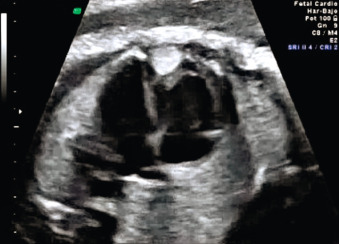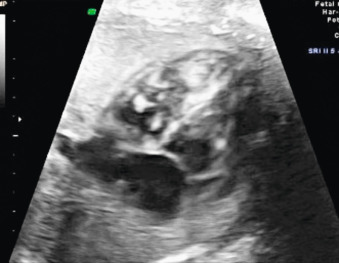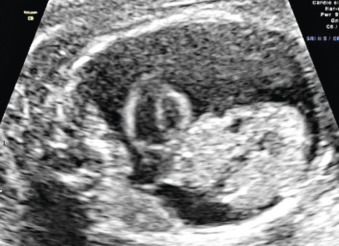Abstract
Cardiac tumors are usually benign (mainly rhabdomyoma, teratoma, fibroma, myxoma, or hemangioma), with no association to other anomalies and good prognosis. The exception to this is multiple rabdomyomas that very frequently associate tuberous sclerosis.
Keywords
cardiac tumors, rhabdomyoma, teratoma, fibroma, myxoma, hemangioma, tuberous sclerosis
Introduction
Cardiac tumors are rare and usually benign with few cardiac complications; most are asymptomatic and eventually involute. Cardiac complications include arrhythmias, obstruction of the ventricular outflow tracts, and secondary cardiogenic shock leading to fetal hydrops and death. Prenatal diagnosis is helpful to monitor these cases and, if necessary, to schedule delivery or perform in utero treatment to improve secondary heart failure.
Disease
Definition
Cardiac tumors are benign (95%) or malignant (5%) neoplasms arising primarily in the inner lining, muscle layer, or the surrounding pericardium of the heart.
Prevalence and Epidemiology
Cardiac tumors are uncommon, with an estimated incidence during fetal life of approximately 1.4 : 1000. The estimated prevalence from pediatric autopsy series is 0.017 : 1000 to 0.28 : 1000.
Etiology and Pathophysiology
Most cardiac tumors are benign (95%). Rhabdomyoma is the most common cardiac tumor during fetal life and childhood ( Fig. 94.1 ). It is followed in frequency by teratoma, fibroma, myxoma, and hemangioma.

Cardiac tumors are usually isolated, with no association with chromosomal anomalies or other structural malformations. The only exception is rhabdomyomas, which show a very high association (75% to 90%) with tuberous sclerosis ( Fig. 94.2 ). Detection of multiple cardiac tumors should raise a strong suspicion of rhabdomyoma and tuberous sclerosis. A detailed family history should be obtained in such patients, and genetic counseling should be offered. Tuberous sclerosis is a rare multisystemic neuroectodermal disease characterized by multiple cardiac, intracranial, renal, pulmonary, and skin tumors. Rhabdomyomas generally regress after birth, although the associated neurodevelopmental complications (four-fifths of patients have epilepsy, and two-thirds have delayed neurodevelopment) dominate the clinical picture and should be an important part of the prenatal counseling of parents.

Prenatally, cardiac tumors are usually detected in the third trimester. Most keep on growing during pregnancy without hemodynamic consequences. However, depending on the size, number, and location, complications such as arrhythmias, coronary flow reduction, or outflow tract or foramen ovale obstruction can occur, triggering heart failure, fetal hydrops, or eventually perinatal death. It is mandatory to perform complete structural and functional echocardiography and to arrange regular follow-up.
Manifestations of Disease
Clinical Presentation
The clinical presentation includes a cardiac mass and occasionally fetal hydrops.
Imaging Technique and Findings
Ultrasound.
The tumor characteristics on ultrasound depend on the histologic content:
- •
Rhabdomyomas (65% to 70%): these are typically multiple homogeneous and hyperechogenic masses within the myocardium or chordae tendineae cordis (see Fig. 94.2 , ).
- •
Teratomas (20% to 25%): these are isolated heterogeneous and encapsulated cystic masses located adjacent to the pericardium. Most cases manifest with accumulation of fluid in the pericardial space, which can trigger fetal hydrops and stillbirth ( Fig. 94.3 , ).











